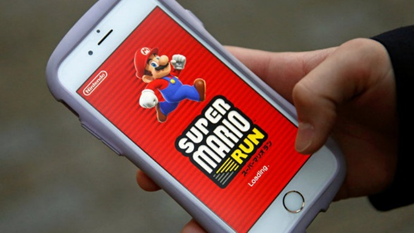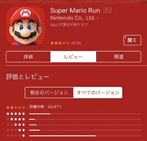1,200 yen for Super Mario Run – why is this expensive? I asked why to people who didn’t buy the game
Shuji Shinohara | Freelance writer on IT
The original Japanese article was published on 11:30 January 5, 2017

Image: Reuter/Aflo
“Super Mario Run”, a Nintendo smartphone game released at the end of last year, exceeded 50 million downloads; fastest in App Store history. Pre-registration of Android apps also began, so it is certain that this record-breaking number of downloads in the history of smartphones will continue to grow in the future.
However, compared to this magnificent number of downloads, its sales is not growing as initially expected.
SuperData, a U.S. provider of market intelligence, initially forecast the sales to be $60 million, however downgraded their expectation to around $12 – 15 million after the release. As if to support this downgrade, App Annie, another research company, announced its research result that the sales for the three days after the distribution was $14 million.
In the iTunes review, majority of the ratings are scored at the lowest “1 star”, criticizing its “high price”. It may be on its way to be negatively labelled as an “app that received the most number of 1 star rating”, due to the size of downloads.

If we take a look at the top grossing ranking, many of the “free with in-app purchases” games which are more expensive than Super Mario Run have won popularity. Why is it that only Super Mario Run is regarded as “expensive”?
I asked the reason to people who “played with Super Mario Run but did not buy it” and was able to know a lot of reasons why it is regarded as “expensive”.
“I don’t pay for smartphone games”
Many of the persons who cooperated in this survey were teenage students. One of the most prominent opinions was: “I don’t pay (use money) for smartphone games.”
“I don’t intend to use money for smartphone games; I don’t think the content is worth the money. Normally, I play with free-to-play games and I’ve never paid for the in-game items.” (High school student)
“It’s simply expensive. 1,200 yen for stage 1-4 until the end; I can’t afford it so I haven’t bought it. Additional challenges such as building a kingdom or playing the same stage three times with different coin locations are fun, so I would have wanted it. I think I will have a look at the additional content and reconsider. I have other things I want, but not enough pocket money. Normally, I play with free-to-play games. I try not to buy the in-game items and I probably feel uncomfortable that the first game I pay for is Mario Run.” (High school student)
“It’s simply expensive and it’s a game just for collecting coins, so I don’t think I will continue playing it – that’s the reason. On top of that, if I complete all the stages, I don’t think there is anything else to play with. I play with free games with ads. I sometimes play games with in-app purchase if the free-to-play part is long. But I never purchase the items.” (Junior high school student)
“For a Mario game, I think 1200 yen is cheap. But there are many smartphone games that can be enjoyed for free, so naturally I think that smartphone games should be free so I refused to pay for Super Mario Run. If there is a new Mario game in a different hardware, I think I would probably buy it.” (High school student)
Many of the students who gave me their views had the perception that “smartphone games are those that can be played for free”. So I received the impression that they could not accept Mario Run’s sales style of “can be played for free, but only for the first part.”
There were others who told me that they want to buy it, but their parents forbid them from paying for in-game items. In many families of junior high school or high school students, parents seem to have the discretion on the purchase of smartphone games.
A mother of ten and seven-year-old boys in her 40s said, “We have a ‘Super Mario Maker’, so it wasn’t worth paying to continue playing the game.” This family had never paid for a smartphone game, but has bought in-game items in Nintendo 3DS games in the past (probably have purchased download games). She also added that “the children didn’t say that they want to keep on playing with the game” in the first place – a rather harsh view towards Nintendo.
“The game is not my taste”
From those users who pay for smartphone games with in-app purchase but did not buy Super Mario Run gave views such as, “I didn’t think I would enjoy enough for the price I paid.”, and “The game is not my taste.”
“I’ll probably quit playing soon, so I thought it would be a waste to buy it; so I didn’t buy it.” (University student in 20s)
“I’m not so good at action games that require hand-eye coordination like Mario Run, and I didn’t think I would enjoy enough to compensate for the money; so I didn’t buy the game.” (Office worker in 30s)
“If I’m spending 1,200 yen for this game, I would rather pay for Hearthstone, music in Deemo, or other apps. It just wasn’t so fun. I suppose a person that likes play-through-type of games would be able to play this for a long time, but casual gamers would be satisfied once they’ve cleared all the stages in a game like Mario and wouldn’t play with it anymore. I asked around today, and there were many who said, ‘I will get bored with it’, ‘too expensive’, and ‘not fun’”. (High school student)
Nintendo has a policy of selling smartphone games in a “free-to-start” style which lets players to play with it free first; therefore, many smartphone users could play with Super Mario Run and this boosted the number of downloads.
However, as a result of being able to play the game for free at first, unlike one time, outright purchase type of games, it gave the option for the users “to compare with other games and not to buy the game.”
What’s most important is this “comparison with other games.”
Users can pay 3,000 yen for a “gacha”, because they can enjoy the games longer
Probably the biggest reason why people wonder “why?” towards views that say, “1,200 yen for Super Mario Run is too expensive”, is the price difference with “Gacha” games (games which employ a system called “gacha” which, by charging a set price, allows users to win rare items, etc. if they are lucky). Compared to 3,000 yen for 10 consecutive “gacha” in “gacha games”, 1,200 yen for Super Mario Run should be “cheap”.
However, I found out from the real voices of users that what is being compared here is not the price, but the appeal of how long the users can enjoy that game.
“For students, 1,200 yen for a smartphone app is expensive.
(“What about 3,000 yen for 10 consecutive gacha in gacha games?”)
That’s a totally different story from 1,200 yen for Super Mario.” (High school student)
“I’ve paid for Puzzles & Dragons. I began paying for it because I never got bored of playing with Puzzles & Dragons and enjoyed it. Pricewise, 1,200 yen for Super Mario Run is cheap, but I couldn’t play the courses at all unless I paid for it, and it wasn’t too fun.” (High school student)
These voices imply that the users would play for an extended amount of time for free, and then make their decision on whether or not to go for the in-app purchase.
This means that users opted not to buy before users could experience the fun because Super Mario Run was structured in a way that users could only play the first three stages for free.
Nintendo still has “Fire Emblem” and “Animal Forest” series to release as smartphone games in this fiscal year. “How long are users allowed to play for free?” – this will be the key factor in their sales.
